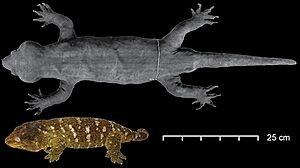Gigarcanum facts for kids
Quick facts for kids Gigarcanum |
|
|---|---|
 |
|
| Model in Lille Natural History Museum | |
| Conservation status | |
| Scientific classification | |
| Genus: |
Gigarcanum
|
| Species: |
delcourti
|
| Synonyms | |
|
|
Gigarcanum delcourti is an extinct type of gecko. It used to be called Hoplodactylus delcourti. This amazing lizard belongs to the family called Diplodactylidae. It is the biggest gecko ever known!
This giant gecko could grow to be at least 60 centimeters (about 2 feet) long, including its tail. Its body alone was about 37 centimeters (14.5 inches) long. We only know about this gecko from one stuffed specimen. It was found without a label in a museum in France. For a long time, no one knew where it came from. Scientists first thought it was from New Zealand. They even thought it might be the "kawekaweau" from Māori stories. But DNA tests now show it came from New Caledonia.
Contents
The Mysterious Gecko's Story
In 1873, a man named Major W. G. Mair wrote about a story from 1870. A Māori chief said he had killed a "kawekaweau." He found it under the bark of a dead rata tree in New Zealand. This is the only time anyone ever said they saw a "kawekaweau" alive. The chief described the animal as "two feet long and as thick as a man’s wrist." He said it was "brown, striped lengthwise with dull red."
In 1986, a single stuffed gecko was found in the basement of a museum in Marseille, France. No one knew when or where it was collected because it had no label. It had been in the museum since at least the 1870s. It might even have been there since the 1830s. This gecko was preserved in a special way. Its insides were removed, and it was dried and mounted. This was different from how most specimens were kept back then.
Scientists named this new species Hoplodactylus delcourti. At first, they thought it was the lost "kawekaweau" from New Zealand. This "kawekaweau" was a giant, mysterious lizard from Māori legends.
Solving the Mystery with DNA
In 1994, scientists tried to get DNA from the gecko, but it didn't work. Later, in 2016, a scientist named Trevor Worthy thought the gecko might be from New Caledonia. He noticed there were no fossil bones of this giant lizard in New Zealand caves. Other New Zealand gecko bones were found there. Because of this, the gecko was not included in a 2021 list of New Zealand reptiles.
Finally, in 2023, scientists successfully got DNA from the specimen. The DNA showed that the gecko was indeed from New Caledonia. It was very different from other geckos. So, scientists gave it a new genus name: Gigarcanum. This new name helps show how unique it is. The DNA also suggested that Gigarcanum is related to other New Caledonian geckos. These include Eurydactylodes, Mniarogekko, and Rhacodactylus.
What's in a Name?
The second part of the gecko's name, delcourti, honors Alain Delcourt. He was the French museum worker who found the forgotten specimen. The first part of the name, Gigarcanum, comes from two Latin words. "Gigas" means giant, and "arcanum" means secret or mystery. So, the name "Gigarcanum" means "giant secret." This name perfectly describes the gecko's large size and its mysterious past.
What the Giant Gecko Looked Like
Gigarcanum delcourti was much bigger than any living gecko today. It was about 50% longer than the largest living gecko, Rhacodactylus leachianus. This living gecko also lives in New Caledonia. Gigarcanum delcourti was likely many times heavier too. Its body was strong and thick. Its tail was long and tapered, like a cone.
The gecko had a large head, which made up about 20% of its body length. Its toes had claws and were slightly webbed. The pads on its toes were wide and rectangular. These pads helped it climb. Its body was yellowish-brown. It had dark reddish-brown stripes running along its back.
How the Giant Gecko Lived
Scientists believe Gigarcanum delcourti was a nocturnal animal. This means it was active at night. It probably lived in trees, climbing them easily. Its diet likely included many insects and other small creatures. It might have also eaten fruit when it was in season.
Like other New Caledonian geckos, it probably laid two eggs at a time. We don't know for sure if it laid eggs (oviparous) or gave birth to live young (viviparous).
Why the Giant Gecko Disappeared
Gigarcanum delcourti was probably already extinct or very rare by the mid-19th century. This was when people started to settle in New Caledonia. Since there are no other records of this species, it likely disappeared before many people even knew it existed.
See also
 In Spanish: Gecko de Delcourt para niños
In Spanish: Gecko de Delcourt para niños



